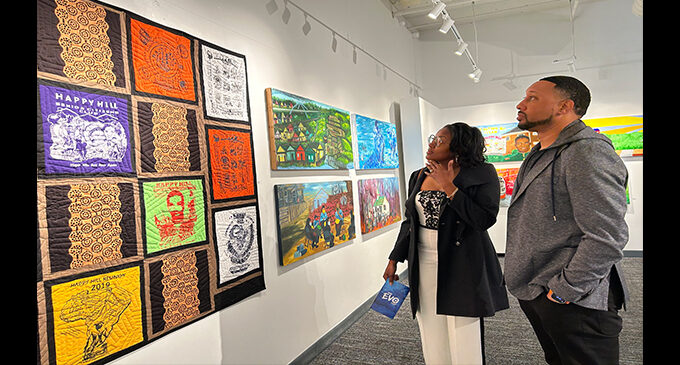Kayyum Allah curates Happy Hill Neighborhood Association Art Anthology exhibit

By Felecia Piggott-Long, Ph.D.
Local artist Kayyum Allah curated the Happy Hill Neighborhood Association Art Anthology (HHNA) exhibit that was recently on display at the Milton Rhodes Center for the Arts from Jan. 19 – Feb. 18. The purpose of the art collective is to create a visual representation that helps to revitalize the oldest African American community in North Carolina. The HHNA Art Anthology was founded in 1999 and established in 2018 by Allah, a resident of Happy Hill.
The Happy Hill community has a vibrant, evolving history, and the HHNA members record this story. The current members of the HHNA include Kayyum Allah, Jerry Hanes, Don Sawyer, Gilbert Young, Amy Binns, Phebe Pankey, Brianna Hairston, Mikaila Muhammad, and Gerald Hayden. They exhibited their work in the Milton Rhodes center as well.
“The Happy Hill Art Anthology coalition is dedicated to reproducing and reclaiming the history of Happy Hill,” said Kayyum Allah. “My mother, Doris Kimbrough, sang with the Ebernette Gospel Singers at Rising Ebenezer Baptist Church. The pastor was Willim C. Brown.”
Allah created a colorful painting of the Ebernette Gospel Singers who often sang at Rising Ebenezer Church in Happy Hill and at various churches around the city and state.
The paintings of the artists in the collective show great interest in the spirituality of Happy Hill, cultural activities, community engagement, and history of the area.
The Happy Hill Reunion is a major part of the exhibit. Many of the t-shirts from the reunion are featured in the art. The very first reunion was held in 1994, and Allah was commissioned to create artwork in the Williams C. Sims Center and for the t-shirts each year. The t-shirt for the year 2000 highlighted the two founders, Ben Piggott and William “Rock” Bitting. Also, Mrs. William C. Sims, community mother Yvonne Jefferson, musician Joe Robinson, and Allah himself are celebrated on this garment.
Ben Piggott was very impressed with the talent and the output of the artists in the collective. “The exhibit was very versatile. I saw variations of Happy Hill history. I was impressed that they reproduced one of the reunion shirts with me, Rock Bitting, Mrs. William C. Sims, Yvonne Jefferson, one of the Happy Hill mothers who had several children who came to the Sims Center, as a symbol of the Happy Hill Reunion,” said Piggott. “Also, Joe Robinson would come to the reunion and perform with his trumpet. That is the first picture you see when you step into the exhibit.
“We saw the Bitting Bridge. Rock’s grandfather received funding and support so they could have a bridge in that area instead of rocks and pebbles,” said Piggott. “After the bridge was made, they would cross from Old Salem into Happy Hill. They put a bridge there at the dividing point between Happy Hill and Old Salem.”
Shasta and Chancellor Staley heard about the exhibit and decided to spend some time in Winston-Salem during the Valentine’s Day weekend. On Feb. 17, they browsed through the exhibit. “We were very impressed with the work of the local artists. I have been to the Happy Hill Garden Reunion before,” said Shasta Staley. “This exhibit brought back many fond memories. I look forward to the next reunion.”
Some of the activities represented included attending the Happy Hill Reunion, gardening, dating, swimming, dancing, going to the market, going to the first African school, living at the Shueman Plantation where the enslaved people lived and worked. Some of the former slaves of Happy Hill left the Shueman Plantation to return to Africa to build the country Liberia, West Africa. The flag of Liberia is red, white, and blue, just like the American flag.
Riding on the Safe Bus was portrayed in one of the paintings. The Safe Bus Company was the largest Black-owned transportation company in the world in 1968 when African Americans and whites in Winston-Salem were riding the bus together.
Many of the paintings pointed to spiritual activities during the worship services in the Rising Ebenezer Baptist Church and in the mosque. Some of these activities were communion, prayer, recognition of the ancestors, living in the shotgun houses, and men going to the Million Man March for a day of atonement.
Allah had a picture of his mother who sang with the Ebenette Gospel Singers. Hattie Fulwood, former member of the Ebernettes, still sings at St. Mark Baptist Church.
“I am so glad she is still singing. She can lay it down,” said Ben Piggott. “My mother asked her to sing at her funeral, and she did a fine job.”
Happy Hill is located less than a mile from Old Salem, but it has developed into an evolving community. Segregation laws and systemic racism has impacted Happy Hill, and much of this area has been removed and destroyed over time. Presently, many projects are in place to restore Happy Hill to its original greatness.
The exhibit received support from artists in the local community, financial contributions from the Thomas S. Kenan Institute for the Arts of UNCSA, and the HHNA. The exhibit is the first fruits of a collaborative harvest. It was presented by the Arts Council of Winston-Salem and Forsyth County in partnership with the Happy Hill Neighborhood Association through support by the Thomas Kenan Institute for the Arts of University of North Carolina School of the Arts.










